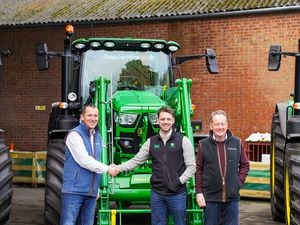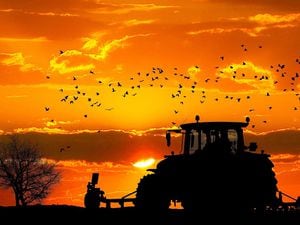Farming under the blazing sun: Agriculture conditions 'worst in generation'
Farms are “hurtling towards a crisis” as the heatwave brings conditions not seen for more than 40 years.

While rain was today expected to bring some respite, hot and sunny weather is forecast to return next week with temperatures returning to the high 20s.
Today farmers explained how they are seeing crops stop growing and wilt, milk yields drop by 20 per cent and livestock struggle with a lack of water and grass.
They also have to operate with the fear of grass fires looming over them, which have the potential to destroy a whole harvest.
Crisis talks were held at this week’s Royal Welsh Show. Rob Matthews, of Shropshire-based rural insurer Lycetts, warned: “Farmers are hurtling towards a crisis point. We have not seen weather like this in decades.
"Farmers have been battling to survive during this heatwave, faced with drought conditions, tinderbox fields, and livestock they can’t feed – they are growing increasingly desperate with every day.”
Feed prices
Shropshire-based agricultural group Wynnstay, said demand for feed had increased dramatically as farmers see supplies diminish.
Mark Price, dairy specialist at Wynnstay, said: “For those grazing cows, the lack of grass growth is starting to impact milk yield and quality, along with cow body condition, so farmers are looking to buffer feed with concentrations or forage based rations.
"That being said, for some, forage stocks are low as a result of the prolonged winter, so there’s concern that eating into first and second cut 2018 silage now will lead to issues this winter.
“As a result, producers are looking to purchase additional feed supplies.
"Although bought-in feed is expensive, this will help to maintain cow condition and milk quality, and with Arla increasing their milk price by 0.88p per litre in August, there’s confidence that the additional costs will be covered.
“Forage shortages are a big concern nationally, but in this region the concerns aren’t as bad as the south west.
“We’ve experienced good quality first and second cut silage, and in general maize is looking pleasing.
"So, my advice would be to plan ahead, ensure you have enough forage to feed the whole herd now and in the winter, and if there’s a shortage, consider the inclusion of additional feed sources.”
Dairy
A farmer has described the current situation as “critical” as he and many others have been forced to feed his animals winter rations.
Richard Yates, who has 300 cows at his farm in Middleton Scriven, near Bridgnorth, said the shortage of straw is also concerning farmers.
He said: “This is once-in-a-generation weather. As a boy I just about remember 1976 and believe we are at those critical levels already.
“I have one week’s grass left for my dairy cows and am already feeding full winter rations like most farmers.
“It is getting serious as there is a series shortage of fodder and straw for the winter.

“It has been a double whammy situation. The Beast from the East meant a lot of farmers kept cattle inside for a month later in the spring, which depleted straw and fodder.
“I would implore arable famers to think about their farming neighbours to bail straw rather than chopping it. When it gets chopped it goes back into the soil and we desperately need all the straw to feed our animals.
“Having to feed the cows means extra cost. It should increase prices of food in theory.
“The cows are not milking as they should be because the fodder is not there. It means I am having to feed them expensive concentrate.
“I have a couple of fields of maize to cut yet. I will silage the fields rather than combine it and put it in the silage pit. Farmers are reluctant to open the silage pits. They often leave it as late as they can do as once they are open they keep using it.
“All farmers have also got to be cautious of potential fire risks on their land as well.”
Mr Yates, also chairman of the NFU West Midlands Livestock Board, said: “The NFU is aware of the seriousness of the issue and are in discussions with Defra on the matter.
“Every farmer is in the same boat.
“They are looking to farming representatives to act and talk to the powers that be, and that is what we are doing.”
Mr Yates farms 850 acres across three units near Bridgnorth. These include 400 acres of arable comprising wheat, barley, beans, maize, potatoes and fodder beet.
Sheep
Sheep are hardy, but that doesn’t mean flocks in Shropshire and Mid Wales aren’t struggling with our ongoing heatwave.
Malcolm Roberts farms sheep and beef cattle on land near Oswestry.
He is also regional board chairman for the NFU, which means he has the ear of farmers from across the region and speaks to them abut the problems they are facing during the long hot summer.
He says it is lack of water rather than the amount of grass that is the current worry for sheep farmers.
“Sheep really do need water and the land that they graze on, marginal land, will have natural ditches and streams,” he said.
“Without water they will lose body condition very quickly.”

He said sheep farmers across the county and into Wales were really concerned as water courses were quickly drying up. Some stretches, like the River Teme, have dried up completely.
Beef cattle and even more so dairy cows, he said, were struggling with not only the lack of grass but the quality of grass on the fields.
“We have had to introduce dried dried food to our bigger cattle about five-to-six weeks earlier than we normally would.
“However, what we call our grazing cattle are coping reasonable well, we just have to ensure they have ready access to water. Like us they don’t need as much food in hot weather. However because dairy cows are constantly producing milk, they do need a lot of forage.”
Mr Roberts said the fear was that there would be no food for the animals for the coming winter.
“The quality of last’s years forage crops was not great and so farmers started the year with barns empty.
“Then we had the Beast from the East and the late spring which meant animals were kept indoors for longer and it affected the first crop silage.
“Anyone who hung on for a late first crop was then hit by the heatwave and did not get a second crop at all.”
He said the NFU had opened its national fodder bank to help farmers in dire straights and said there were also farming charities that could help.
Pigs
Pigs struggle in the heat and that means more work and expense for those looking after them.
Sam Jones, from Church Stretton, keeps Kune Kune pigs on a smallholding.
The problems she is experiencing are replicated on a larger scale on pig farms across the country.
She is spending time hosing her pigs down to ensure they keep cool.
And, in a problem shared by livestock farmers from all sectors, she has also had to start feeding them winter feed.

That means she is storing up problems and more expense in months to come, when she will be forced to buy in feed to keep her animals nourished through the winter.
Her 14 rare breed sheep have been moved to fresh land due to the grass not growing.
Meanwhile, two donkeys she also looks after, Windsor and Glengarrie, are already eating into the hay reserves she had put by and that were meant for winter.
She said: “This winter is going to be a bit of a feed crisis generally.
“Already it is of a big concern.
“The weather has meant farmers are having to feed their animals on winter supplies. This in turn is inevitably going to push prices up for straw and hay.
“Other farmers are now having problems with the harvest as there is a low yield.
“It is really very challenging for people.”
Sam has 11 pigs, which she breeds for export to the Netherlands as part of a conservation project. The donkeys, sheep and lambs are bred for meat.
She said the animals she keeps all have different needs. Donkeys are desert animals and therefore cope better. But the pigs are particularly vulnerable to high temperatures and that means cooling them down with a hose is an important daily routine.
Market garden
The heatwave is causing a logistical nightmare for gardeners at Attingham Park.
The National Trust property on the outskirts of Shrewsbury undertook a 10-year project to bring the estate’s walled garden back in to use.
Today the garden, with its orchard of 160 trees, is a hive of activity with fruit, vegetables and flowers grown throughout the year and is a haven for wildlife, including the Attingham bees.
But high temperatures are meaning that work in the garden, known by visitors for its stunning blooms is having to be prioritised.

Flora Holdsworth, from the estate, said: “As the heatwave continues, gardens can struggle to cope with the prolonged high temperatures.
“The gardens team at Attingham Park are using various methods to counteract the impact of such sustained heat on the plants.
“Lawns are left alone – the grass has turned brown, but will tough it out and bounce back.
“The amount of watering is limited – vegetable and fruits take highest priority over all other plants.
“Vegetable beds are mulched to reduce the amount of watering required, and where possible we water herbaceous beds using collected rainwater.
“All aspects of the garden are being monitored to establish which plants can and can’t survive in this dry period to enable the gardeners to plan ahead for similar events.”
The walled garden had flourished and declined with the Berwick’s family fortunes, five generations of which lived at Attingham, with the garden being built around the same time as the mansion in the late 18th century.
The garden was used for a variety of purposes over the years, and gradually areas became disused, and the structures fell into disrepair.
Quinoa
Reductions in yield and spending more time on irrigation are among the impacts felt by farmers during the heatwave, according to Stephen Jones.
Mr Jones, who runs The British Quinoa Company near Ellesmere, said some crops are suffering more than others as farmers and growers find ways to protect crops.
He said: “Essentially the biggest impacts are the reduction in yield and the time spent irrigating things like potatoes. Spending a lot of time and money on irrigation is not financially viable or practical. The price of straw has also gone through the roof.
“We won’t have to dry the grain because it is dry enough.
“This is definitely the worst hot and dry weather I have known.”

As well as quinoa and potatoes, Mr Jones also grows maize and oil seed rape. “The maize looks okay but some of the others are struggling.
“Other crops such as sugar beet are struggling. But wheat and oil seed rape planted in the winter won’t be so affected.
“Quinoa is supposedly more drought resistant but what you will get is a reduced grain size. What you want is a nice big white grain.
“Because of the weather in the spring we had to wait longer to get things into the ground. We had to delay until April when they should have been in sooner.
“It depends what you grow and when you harvest, but rain now can actually have a detrimental affect on quality.”
Quinoa – pronounced “keen-wah” – originated in the foothills of the Andes and has won fans over here among ordinary families as a health food and a tasty alternative to rice.
Now producers here have found a variety that can cope with the British climate and, arguably, is even healthier.
Vineyard
While farmers elsewhere fear the worst, vineyards are looking forward to reaping the rewards as the sun burns down.
This year is expected to provide the best harvest yet, due to the ongoing heatwave.
Halfpenny Green Wine Estate, near Bridgnorth, has been producing wine for the past 30 years – but it has never known a year like this one.

Owner Martin Vickers knows what it takes to produce a good harvest and said this year looks set to be a record year, with yields up by around a quarter on a normal year.
He added: “The hot dry weather has been of huge benefit to our vines.
“They flower in late June and require, hot, dry, sunny weather. The result this year has been a 100 per cent fruit set.
“The continuing heatwave has meant that the crop is developing in a way we have not seen in 35 years of growing.
Halfpenny Green Wine Estate planted its first half acre of grape plants back in 1983.
The vineyard is now one of the largest in the UK, boasting around 30 acres in total.
The estate sits 250ft above sea level in well-sheltered south facing slopes, with light, sandy free-draining soil.
Mr Vickers added: “Vines are a Mediterranean plant, so have the ability to send down very deep tap roots into the water table, whilst loving the heat above ground level.
“A record year in terms of yield and quality should result in October, when we harvest.”
The company also has its own winery which was built in 2005.
Between 50-60,000 bottles of wine are made each year, all from grapes grown at the site. It also boasts its own restaurant.





